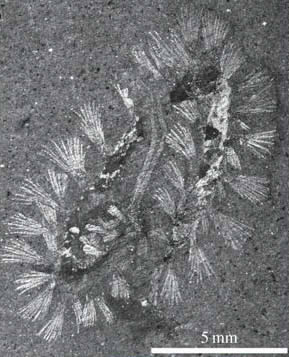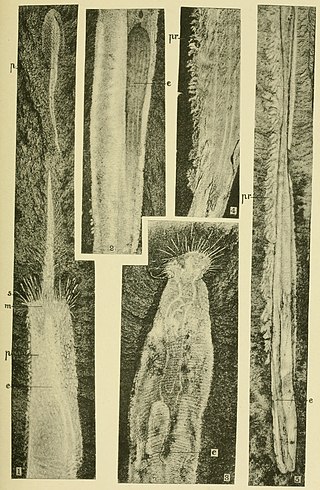
The Burgess Shale is a fossil-bearing deposit exposed in the Canadian Rockies of British Columbia, Canada. It is famous for the exceptional preservation of the soft parts of its fossils. At 508 million years old, it is one of the earliest fossil beds containing soft-part imprints.

Ottoia is a stem-group archaeopriapulid worm known from Cambrian fossils. Although priapulid-like worms from various Cambrian deposits are often referred to Ottoia on spurious grounds, the only clear Ottoia macrofossils come from the Burgess Shale of British Columbia, which was deposited 508 million years ago. Microfossils extend the record of Ottoia throughout the Western Canada Sedimentary Basin, from the mid- to late- Cambrian. A few fossil finds are also known from China.

Yohoia is an extinct genus of megacheiran arthropod from the Cambrian period that has been found as fossils in the Burgess Shale formation of British Columbia, Canada. The type species, Yohoia tenuis, was described in 1912 by Walcott, who considered it an anostracan crustacean. 711 specimens of Yohoia are known from the Greater Phyllopod bed, where they comprise 1.35% of the community. In 2015, Conway Morris et al. reported another species, Y. utahana, from the Marjum Formation, Utah.
Fieldia is a genus of worms known from the Cambrian Burgess Shale, and assigned to the priapulids.

Odaraia is a genus of bivalved arthropod from the Middle Cambrian. Its fossils, which reach 15 centimetres (5.9 in) in length, have been found in the Burgess Shale in British Columbia, Canada.

Burgessochaeta is an extinct genus of polychaete annelids from the Middle Cambrian. Its fossils have been found in the Burgess Shale in British Columbia, Canada. A total of 189 specimens of Burgessochaeta are known from the Greater Phyllopod bed, where they comprise 0.36% of the community. Specimens have also been found at Marble Canyon. The genus was described by Conway Morris (1979) and re-examined by Eibye-Jacobsen (2004).
A number of assemblages bear fossil assemblages similar in character to that of the Burgess Shale. While many are also preserved in a similar fashion to the Burgess Shale, the term "Burgess Shale-type fauna" covers assemblages based on taxonomic criteria only.

Ancalagon minor is an extinct priapulid worm known from the Cambrian Burgess Shale.

Marble Canyon is a canyon surrounding Tokumm Creek just above its confluence with the Vermilion River, at the north end of Kootenay National Park in the Canadian Rockies of British Columbia, Canada. South of Marble Canyon on Highway 93 is Numa Falls on the Vermillion River.

Herpetogaster is an extinct cambroernid genus of animal from the Early Cambrian Chengjiang biota of China, Blang Formation of China, Pioche Formation of Nevada and Middle Cambrian Burgess Shale of Canada containing the species Herpetogaster collinsi and Herpetogaster haiyanensis.
The Phyllopod bed, designated by USNM locality number 35k, is the most famous fossil-bearing member of the Burgess Shale fossil Lagerstätte. It was quarried by Charles Walcott from 1911–1917, and was the source of 95% of the fossils he collected during this time; tens of thousands of soft-bodied fossils representing over 150 genera have been recovered from the Phyllopod bed alone.
Cambrorhytium is an enigmatic fossil genus known from the Latham Shale (California), and the Chengjiang (China) and Burgess Shale lagerstätte. 350 specimens of Cambrorhytium are known from the Greater Phyllopod bed, where they comprise 0.7% of the community.
Mackenzia is an elongated bag-like animal known from the Middle Cambrian Burgess Shale. It attached directly to hard surfaces, such as brachiopod shells. 14 specimens of Mackenzia are known from the Greater Phyllopod bed, where they comprise <0.1% of the community. Mackenzia was originally described by Charles Walcott in 1911 as a holothurian echinoderm. Later, Mackenzia is thought to be a cnidarian and appears most similar to modern sea anemones.

Louisella is a genus of worm known from the Middle Cambrian Burgess Shale. It was originally described by Charles Walcott in 1911 as a holothurian echinoderm, and represents a senior synonym of Miskoia, which was originally described as an annelid. 48 specimens of Louisella are known from the Greater Phyllopod bed, where they comprise < 0.1% of the community. It has been stated to have palaeoscolecid-like sclerites, though this is not in fact the case.

Insolicorypha is a genus of polychaetes known from the Middle Cambrian Burgess Shale. A single specimen of Insolicorypha is known from the Greater Phyllopod bed. The genus was described by Conway Morris (1979) and re-examined by Eibye-Jacobsen (2004).
Peronochaeta is a genus of annelid known from the Middle Cambrian Burgess Shale. 19 specimens of Peronochaeta are known from the Greater Phyllopod bed, where they comprise < 0.1% of the community. The genus was described by Conway Morris (1979) and re-examined by Eibye-Jacobsen (2004).

Pollingeria is a problematic genus of animals of the Middle Cambrian Burgess Shale. 3080 specimens of Pollingeria are known from the Greater Phyllopod bed, where they comprise 5.85% of the community.

Selkirkia is a genus of predatory, tubicolous priapulid worms known from the Middle Cambrian Burgess Shale, Ogygopsis Shale and Puncoviscana Formation. 142 specimens of Selkirkia are known from the Greater Phyllopod bed, where they comprise 0.27% of the community. In the Burgess Shale, 20% of the tapering, organic-walled tubes are preserved with the worm inside them, whereas the other 80% are empty. Whilst alive, the tubes were probably vertical, whereas trilobite-occupied tubes are horizontal.
Stephenoscolex is a genus of polychaete worm known from the Middle Cambrian Burgess Shale. 150 specimens of Stephenoscolex are known from the Greater Phyllopod bed, where they comprise 0.29% of the community. The genus was described by Conway Morris (1979) and re-examined by Eibye-Jacobsen (2004).

This is a list of the biota of the Burgess Shale, a Cambrian lagerstätte located in Yoho National Park in Canada.













